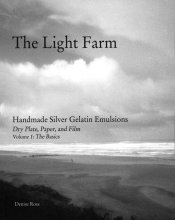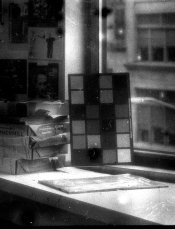Simon Howers
Member
Available from Blurb.com
Denise Ross is a photographer with a wide range of industrial and practical experience. She has been making and coating emulsions for about ten years and has now launched into print to share her methodology and philosophy with us.
The book is a typical high quality Blurb product with copious illustrations. It is currently available soft cover only.
Denise writes well in a relatively non-technical and accessible style. It explains how to make basic "colourblind" and then orthochromatic emulsions using erythrosine dye. The explanations and methods are aimed at small-volume batch production using, for the most part, domestic equipment. It then explains the practical aspects of how to use the emulsion you have made by the manufacture of dryplates, sheet film, paper-backed roll film and photo paper.
The 'make it yourself' style continues with sections on dryplate holders, glass emulsion wells, anti-halation backing and even home-made gelatin filters.
Where the book does particularly well is in the explanation of how to use the emulsions you make and what it is you are actually doing with filtration and exposure - this complements the 'nuts & bolts' text (how to make emulsion, coat etc) very well and certainly raises it above other publications in this area.
The text is full of practical hints & tips for a successful foray into this fascinating and fulfilling activity.
Further books on more advanced topics are promised.
Recommended.
Simon
Denise Ross is a photographer with a wide range of industrial and practical experience. She has been making and coating emulsions for about ten years and has now launched into print to share her methodology and philosophy with us.
The book is a typical high quality Blurb product with copious illustrations. It is currently available soft cover only.
Denise writes well in a relatively non-technical and accessible style. It explains how to make basic "colourblind" and then orthochromatic emulsions using erythrosine dye. The explanations and methods are aimed at small-volume batch production using, for the most part, domestic equipment. It then explains the practical aspects of how to use the emulsion you have made by the manufacture of dryplates, sheet film, paper-backed roll film and photo paper.
The 'make it yourself' style continues with sections on dryplate holders, glass emulsion wells, anti-halation backing and even home-made gelatin filters.
Where the book does particularly well is in the explanation of how to use the emulsions you make and what it is you are actually doing with filtration and exposure - this complements the 'nuts & bolts' text (how to make emulsion, coat etc) very well and certainly raises it above other publications in this area.
The text is full of practical hints & tips for a successful foray into this fascinating and fulfilling activity.
Further books on more advanced topics are promised.
Recommended.
Simon








 Hope everyone has as much fun as I've been having making emulsions.
Hope everyone has as much fun as I've been having making emulsions.